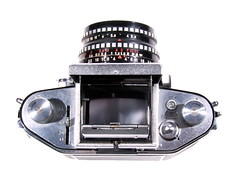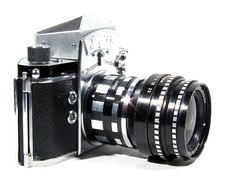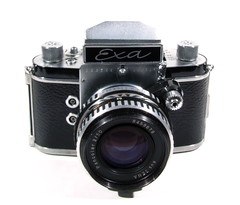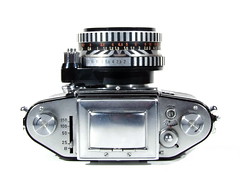Exa (original)
The Exa is a 35mm SLR made in Dresden, Germany by Ihagee. It was introduced in 1951, and began a long-running series of Exa models, which ran alongside the venerable Exakta line.
It is a simplified budget counterpart of the Exakta Varex cameras (the Exakta V and VX); indeed, the first models, made in very small numbers in 1950, were labelled Exa Varex[1].
While the body is smaller and thicker, and this is the main outward difference from the Exakta Varex, the real difference is in the shutter: in place of a Leica-style focal plane shutter, the mirror doubles as the 'opening' shutter blade, and a curved metal piece is the 'closing' blade[2], a form of guillotine shutter. This shutter is not capable of either very fast or slow speeds; the range is from 1/25 sec. to 1/150 sec[3].
The low maximum shutter speed limits the usefulness of the camera with long lenses. A further consequence of this design was cropping of the top and bottom of the image when long lenses, extension tubes, or bellows were used, described as "marginal vignetting" in the instruction manual. This began to appear with 70mm lenses, and was obvious at 100mm and above.
Like all Exaktas, the shutter release button is on the left and on the front of the body, not on the top plate[4]. It is threaded for a cable release, though it is often covered by the aperture coupling of automatic lenses. All "internal bayonet" Exakta lenses should mount on an Exa, and the shutter release is in the proper place to be actuated by automatic lenses' aperture couplings. Later Exaktas added a second set of bayonet flanges for larger lenses, outside the camera, which was not present on the original Exas. It may be possible to retrofit an Exa with this bayonet ring, though one questions the utility of this.
Film advance and rewind are by simple milled knobs. There is a manually-reset frame-counter, with a knurled ring to set it. The viewfinders on all of the original models are removable, and a number of different prism and waist-level finders (fully-featured, with built-in loupe, and most folding to offer a direct-vision frame finder), were available. The original waist-level finder includes a prong that enters a hole on the top of the camera, which prevents exposures when the hood is closed.
Between 1951 and 1962, a number of cosmetic and minor technical changes were made in the design of the camera. A type-numbering system for these devised by Clément Aguila[5] is widely used[6]. This recognises six major types/versions, distinguishable by changes in the finish of the lens mount, the number, finish and synchronisation class of the flash synchronisation sockets, and the style of the nameplate, among other features. Sub-types of some of the types are recognised.
Andrzej Wrotniak made a very sensible classification, listed on his website. It is multi-dimensional in setup, without being complicated. It is an improved version of the Aguila and Rouah classification in their 2003 edition of Exakta cameras 1933 - 1978.
Contents
Common specifications of the versions
- Lens: interchangeable, original Exakta bayonet mount; many manufacturers[7]
- Lens release: via an exposed lever on the left of the lens flange
- Shutter: vertically acting guillotine using the mirror as one component; due to this maximum speed is limited to 1/150, speeds: 1/25-1/150 +B
- Shutter release: on front of the body, available to aperture levers/plungers on various automatic lenses
- Viewfinder: standard Varex finders, with option for exposure interlock (WLF have prong that blocks exposure if the hood is closed.)
- Finder release: via a slider beneath the Exa logo
- Mirror: part of shutter, non-returning
- Bodies: metal, robust construction
Exa Version 1
- Produced between 1951-52
- There are 5 sub-versions [8]
- There are many cosmetic variations also
- Special features of the version:
- Two pairs of flash sockets of the old Vacublitz style, overlapping (i.e., the top pair (M) are interleaved with the bottom pair (X) to save space)
- Shutter setting by lever on top plate: speeds 1/25, 1/50, 1/100, 1/250 & B, top speed changed almost immediately to 1/150s.

|
| Exa Version 1.1 w/ E.Ludwig Meritar 50mm f/2.9 image by Rick Soloway (Image rights) |
Exa Version 2
- Produced between 1953-56
- Special features of the version:
- Two black Prontur-Compur flash sockets (PC sockets)
- Safety locking cap for shutter release
- Exa Version 2 in Captain Jack's website w/ Isco-Göttingen 50mm f2.8 Westar
- Exa Version 2 in F.W.Tappe's website w/ Meyer-Optik Görlitz Trioplan 50mm f/2.9
Exa Version 3
- Produced in 1954
- Numerous variants exist
- Special features of the Exa Rheinmetall:
- System Exa VEB Rheinmetall Sömmerda [9] engravings instead of Exa Ihagee Dresden on the front plate
- Engraving Rheinmetall is on the back of the waist level view finder
- Most features are identical to version 2

|
| Exa Version 3 w/ E.Ludwig Meritar 50mm f/2.9, image by Mario Reisner (Image rights) |
Exa Version 4
- Produced between 1956-59
- Special features of the version:
- Similar with Versions 2 or 3, except for the Exa Ihagee Dresden logo
- Flash PC sockets are chrome, not black
- Added a removable spindle in the hinge, thus the back cover can be detached
- The film guides of the pressure plate are omitted

|
| Exa Version 4 w/ Meyer-Optik Görlitz Trioplan 50mm f/2.9 (on a teleconverter) and SLR prism finder image by John Nuttall (Image rights) |
Exa Version 5
- Produced between 1959-60
- Special feature of the version:
- This model is identical to version 4 except Exa logo on the front plate is embossed, not engraved like in all other versions

|
| Exa Version 5 (1959) w/ Meyer-Optik Görlitz Lydith 30mm f/3,5 (Zebra) image by Süleyman Demir (Image rights) |
|
|
| ||||||
| Exa Version 5 (1959) w/Waist level finder; w/SLR prism finder; w/Teleconverter
Images by Süleyman Demir (Image rights) | ||||||||
Exa Version 6
- Produced between 1960-62
- There are numerous variants of the version
- Special features of the version:
- New rectangular shape of the front plate
- New black and white Exa name plate
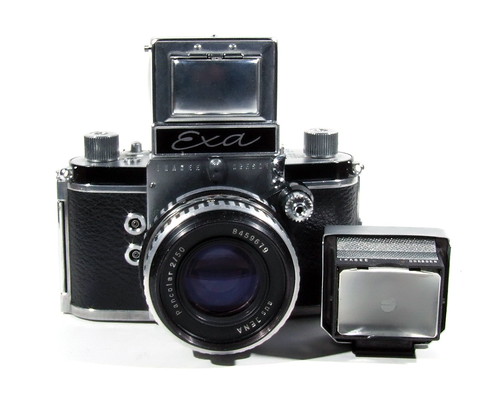
|
| Exa Version 6 (1961) w/ aus Jena Pancolar 50mm f/2 (Zebra), image by Süleyman Demir (Image rights) |
|
|
| ||||||
| Exa Version 6 (1961) w/SLR prism finder; w/Waist level finder; Modular system
Images by Süleyman Demir (Image rights) | ||||||||
Notes
- ↑ McKeown, p 422.
- ↑ The medium-format KW Pilot Super has a very similar shutter mechanism.
- ↑ The very earliest model claimed a top speed of 1/250 second (McKeown).
- ↑ The rewind-release button is on the right, where those unfamiliar with the camera might expect the shutter release to be.
- ↑ Aguila, Clément Exakta Cameras 1933-1978, ISBN 0-906447-38-0. Cited by McKeown.
- ↑ By McKeown, in Olaf Nattenberg's Exakta and Exa Pages and in Jack Dugrew's Captain Jack's Exakta Site among others
- ↑ Ihagee did not produce their own lenses. Instead, they relied on many of the major optical firms of their day to each produce a series of lenses for their cameras, eg. Carl Zeiss Jena, Meyer-Optik Görlitz, Schneider-Kreuznach and E.Ludwig. The lenses from these makers, in terms of the number and variations of lenses produced, are the most plentiful. Maybe over 80% of the Exaktas are equipped with normal focal length lenses from these firms.
- ↑ according to Andrzej Wrotniak and F.W.Tappe
- ↑ In 1954 the Ihagee plants in Dresden got problems with their production capacity. So they startet up a production in the Rheinmetall plants in Sömmerda. The production in Sömmerda was finished soon in the beginning of 1955 with the quantity of 15000-21000 cameras
Links
- in Andrzej Wrotniak's website
- in Captain Jack's website
- in Maurizio Frizziero's website
- Exa Instruction Manual at Butkus.org
- Exa 1 Instruction Manual at Butkus.org
- Several of the Exa types are shown in the Exa Gallery on Olaf Nattenberg's Exakta and Exa Pages (text in German)
